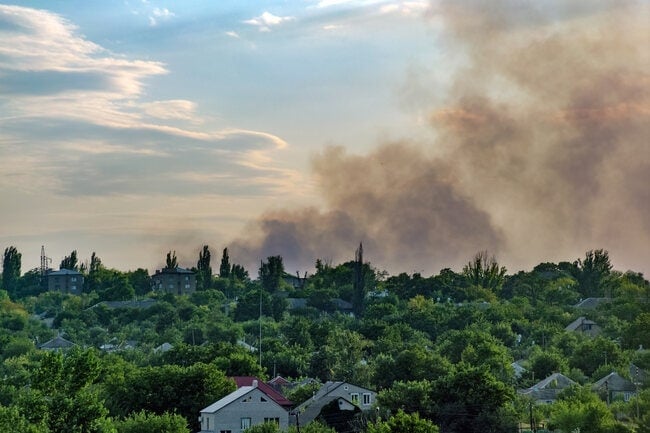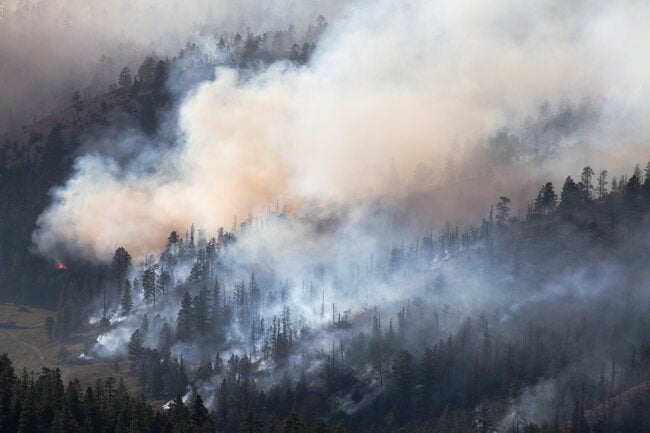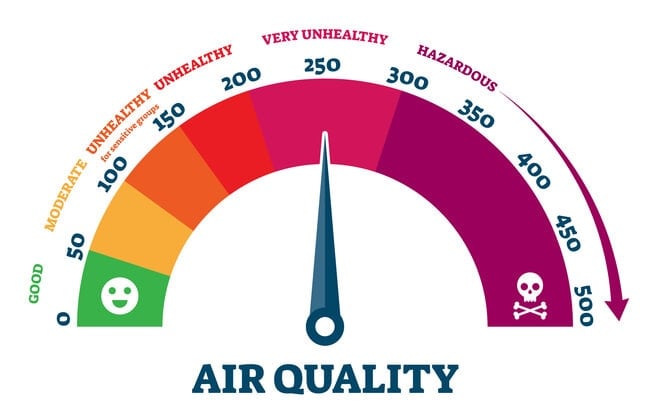Tips For Air Pollution And Poor Air Quality

Hotter and drier weather conditions in recent years have heightened wildfire activity across the globe, resulting in twice as many forests being burnt than 20 years ago. Besides forest damage and property loss, hazardous air quality can cause serious harm—especially to those with preexisting health challenges. Ahead, learn what you can do to protect yourself and your family, including how to create your own air purifier.
The Dangers Of Wildfire Smoke
Wildfire smoke contains particulate matter (dust, dirt, soot), carbon dioxide, nitrogen oxide, and various volatile organic compounds that significantly compromise air quality in the area (and areas downwind). Particulate matter is the primary public health concern for short and long-term exposure to wildfire smoke.
90% of particle mass emitted from wildfires consists of fine particles, some of which are small enough to penetrate lung membranes, damage respiratory systems, and pass into the blood stream. For example, fine particles designated as “PM2.5” are less than 2.5 micrometers in size (a fraction of the width of a human hair) that are small enough to be suspended in the air.

The effects of short-term exposure to smoke and particles range from headache, fatigue, and eye irritation to respiratory tract disturbances such as coughing and shortness of breath. Increases in PM2.5 and ground-level ozone have also been linked to more serious disorders, including reduced lung function, intensified asthma, bronchitis, heart failure, and premature birth.
Hospitals report upticks in respiratory illnesses on days when air quality is poor. Long-term effects are linked to a host of issues, including inflammation, and a greater risk of heart attack and stroke.
Air Pollution Ratings
When officials classify your air as “unhealthy” or “hazardous,” what does that mean? A nationwide measurement system called the Air Quality Index (AQI) is used to determine the severity of air pollution and categorizes the health risks involved.

The Environmental Protection Agency (EPA) calculates the AQI based on five “major pollutants”: ground-level ozone, particulate matter, carbon monoxide, sulfur dioxide, and nitrogen dioxide, with ground level ozone and airborne particles considered to be the greatest health threat. The index is based on a value between 0 and 500 and uses six color-coded categories, with the lower the number, the cleaner the air. Green (0-50) good; Yellow (51-100) moderate; Orange (101-150) unhealthy for sensitive groups; Red (151-200) unhealthy; Purple (201-300) very unhealthy; Maroon (301 and higher) hazardous.
See Your Region’s Air Quality Score
See your region’s air quality at AirNow.gov. This index provides the latest AQI status in your area. Enter your ZIP code to get the latest value and color category for your area. It will also tell you which pollutants are causing the issue, who is at risk for health complications, and which activities are deemed safe. Bear in mind that the Air Quality Index may fluctuate throughout the day as weather patterns move through the area and conditions change.
Air quality is considered “satisfactory” when the index is no more than 50, with 51-100 being “acceptable.” Anything higher than 100 could pose health risks, with EPA categorizing any air quality index over 150 as unhealthy for the general public. Risk of health issues increase as pollution worsens.
What Can you Do To Stay Healthy?
While raging fires and pluming smoke may be beyond your control, there are steps you can take to reduce your risk of wildfire smoke.
- Check local air quality report regularly and stay tuned for public health messages regarding smoke forecasts and safety measures.
- Stay inside if possible. Avoid outdoor, strenuous activity—particularly if you are older or have pre-existing health concerns.
- Wear a mask such as the N95 respirator to protect yourself when venturing outside during wildfire smoke events is absolutely necessary. Consider wearing a mask any time that conditions are listed as “poor.”
- Avoid activities that can increase indoor air pollution such as burning candles and using fireplaces and gas stoves. Avoid vacuuming when air quality is poor as it stirs up particles already inside your home.
- Keep doors and windows closed. Wildfire smoke may seep inside and affect the air quality indoors.
- Use air conditioners as needed. Be sure to keep the fresh air intake closed and the filter clean.
- Invest in air purifiers with HEPA filters to reduce fine particles that come indoors.
- Make your own air cleaners (See below). Commercial air cleaners may be difficult to obtain during wildfires due to supply issues and increased costs, so health and air quality agencies recommend making DIY air cleaners.
DIY Air Purifiers
In an attempt to make sure everyone has clean air, many health and air quality agencies are providing the public with instructions for DIY air cleaners to help clean indoor air during smokey conditions as an affordable and accessible alternative to commercially available air cleaners. Air cleaners can be constructed by attaching an air filter to a box fan, using tape, brackets, or bungee cords. Place the filter on the back of the fan with the airflow arrow pointing towards the fan. When the fan is turned on it should pull air through the filter. Change the filter when it changes color to gray or at the manufacturer’s recommendations.
Research is still being conducted on the effectiveness of removing fine particle matter indoors using this method, however preliminary findings suggest that this makeshift model can potentially work as well as a small size commercial air cleaner. Safety concerns regarding unintended use of fans leading to overheating and starting fires have been tested in many studies across many scenarios and fans, and there were no observable fire risks. With any electrical device, use with caution and always use newer model box fans (after 2012), which have added safety features.
Disclaimer: Farmers’ Almanac does not give medical advice nor advise this method for air purification.
Other Side Effects Of Wildfires
Poor air quality isn’t the only catastrophic side effect of wildfires. Water supplies may be negatively impacted during active burning and for years afterwards. Water is a natural resource we depend on for drinking, irrigation, and fishing and recreation, with 33% of the world’s largest cities depending on water supplied from forested watersheds.
Forests and trees reduce erosion and flooding and increase infiltration, which prevents sedimentation and other pollutants from reaching water supplies. Wildfires also leave the ground burned, barren, and unable to absorb water, putting areas at increased risk of flooding, flashfloods, and debris flows (mudflows). Cities are especially susceptible to flooding since they have high amount of impermeable surfaces, such as sidewalks and roads, which result in more rain runoff.
Join The Discussion
Has your community experienced air pollution from wildfires?
Does your town or city have poor air quality currently?
Share with your community here in the comments below!
Related Articles
9 Tips To Reduce The Threat Of Wildfires
10 Things You Should Never Burn In Your Fireplace

Natalie LaVolpe
Natalie LaVolpe is a freelance writer and former special education teacher. She is dedicated to healthy living through body and mind. She currently resides on Long Island, New York, with her husband, children, and dog.





